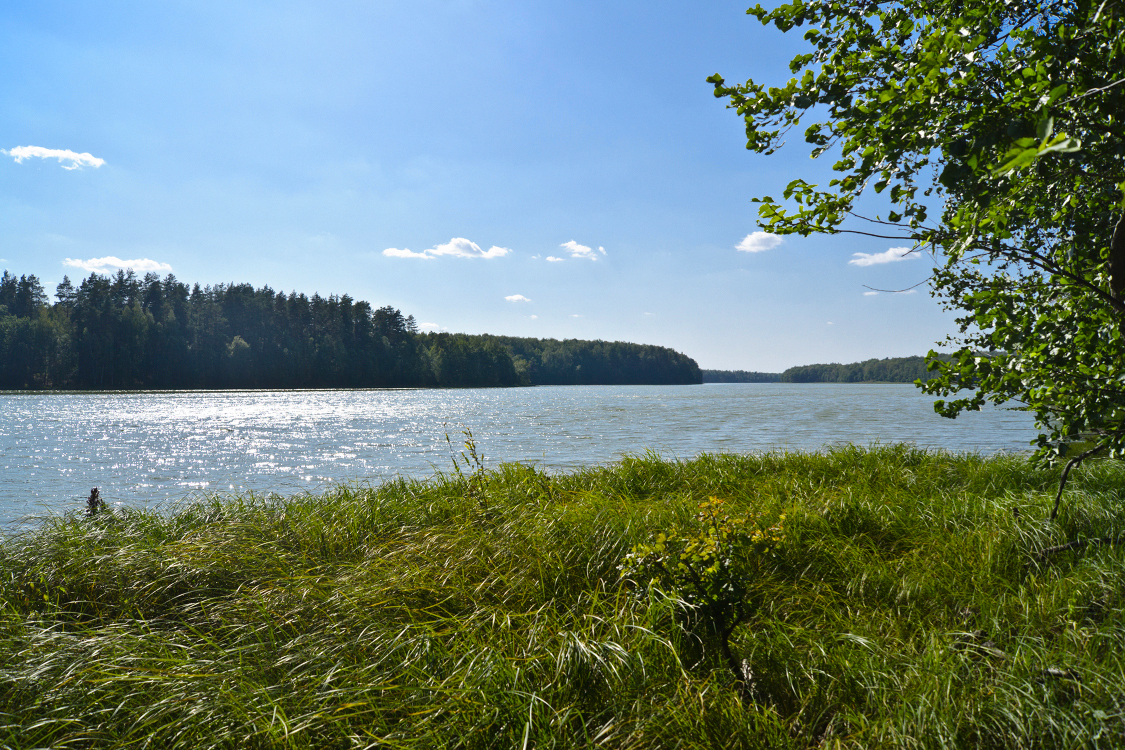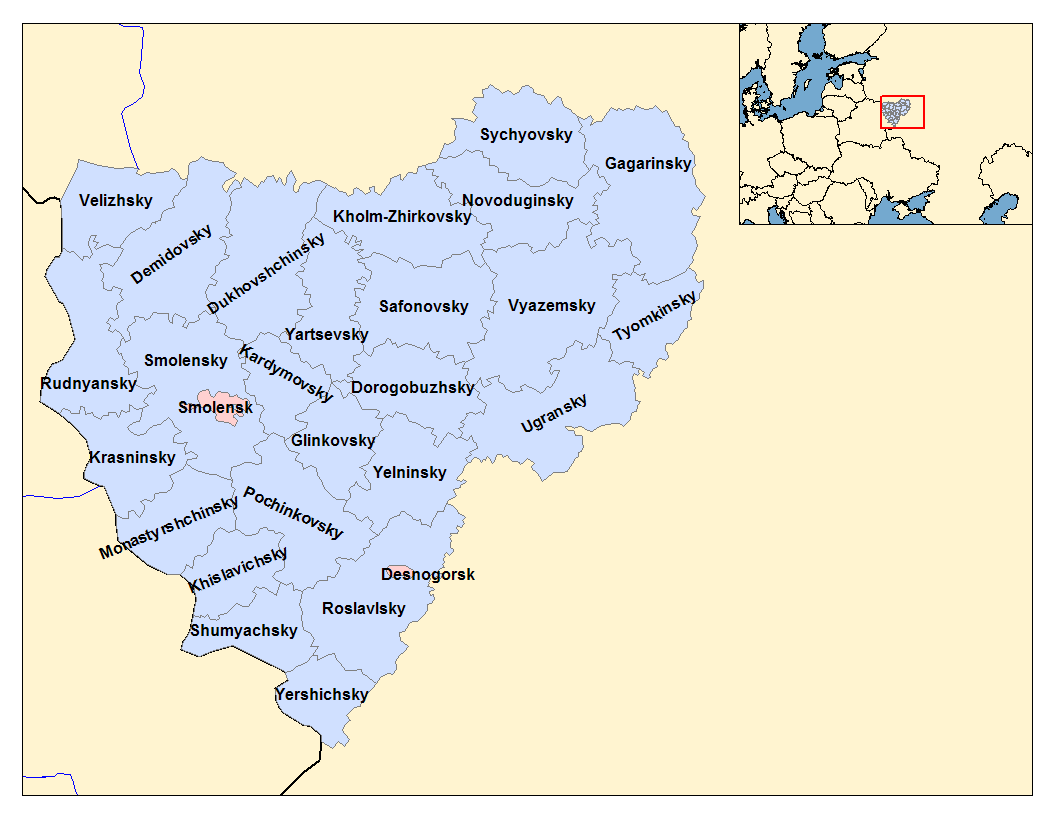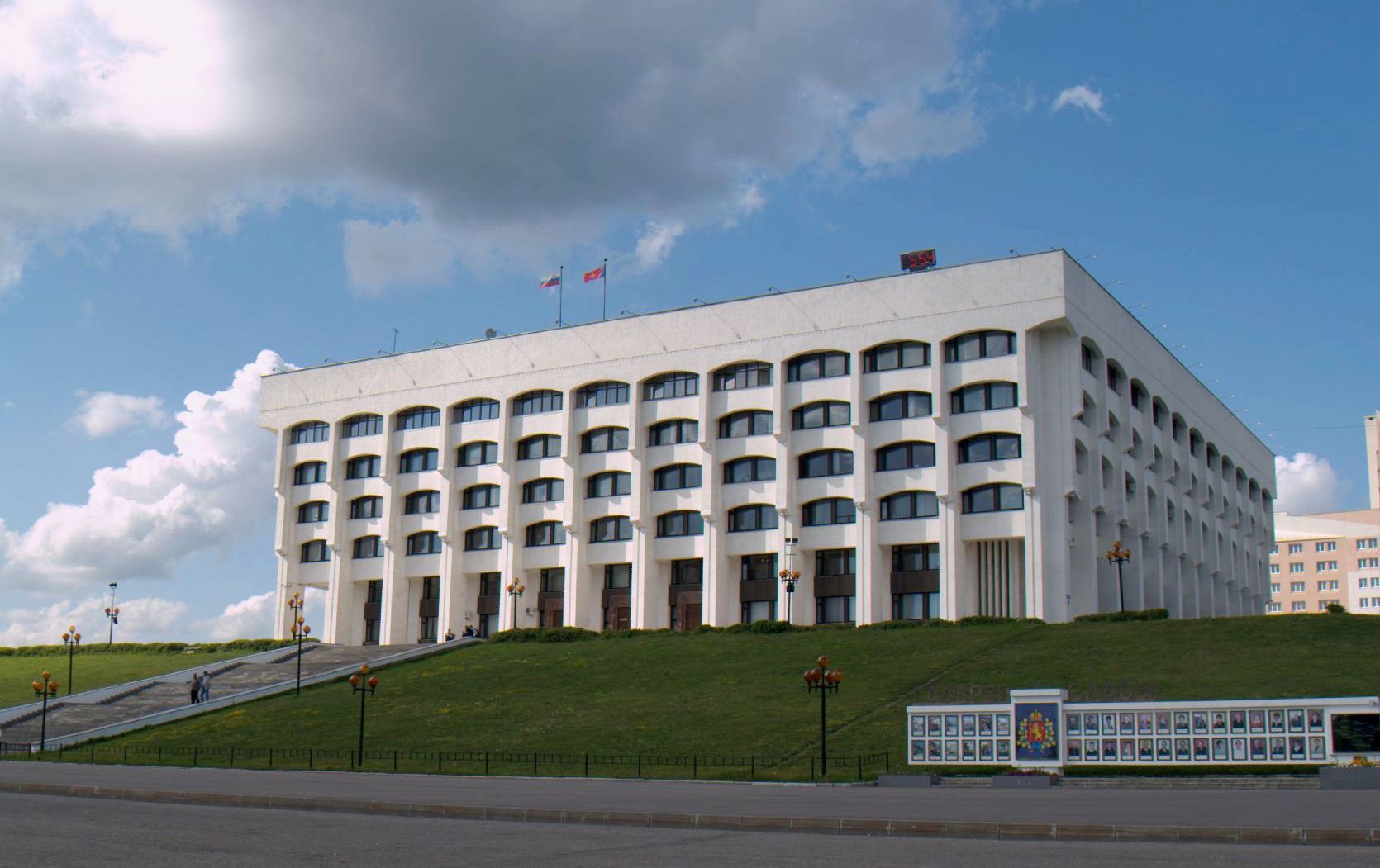|
Moscow Region
Moscow Oblast ( rus, Моско́вская о́бласть, r=Moskovskaya oblast', p=mɐˈskofskəjə ˈobləsʲtʲ), or Podmoskovye ( rus, Подмоско́вье, p=pədmɐˈskovʲjə, literally "under Moscow"), is a federal subject of Russia (an oblast). With a population of 7,095,120 ( 2010 Census) living in an area of , it is one of the most densely populated regions in the country and is the second most populous federal subject. The oblast has no official administrative center; its public authorities are located in Moscow and Krasnogorsk (Moscow Oblast Duma and government), and also across other locations in the oblast.According to Article 24 of the Charter of Moscow Oblast, the government bodies of the oblast are located in the city of Moscow and throughout the territory of Moscow Oblast. However, Moscow is not named the official administrative center of the oblast. Located in European Russia between latitudes 54° and 57° N and longitudes 35° and 41° E ... [...More Info...] [...Related Items...] OR: [Wikipedia] [Google] [Baidu] |
Central Federal District
The Central Federal District ( rus, Центра́льный федера́льный о́круг, r=Tsentralny federalny okrug, p=tsɨnˈtralʲnɨj fʲɪdʲɪˈralʲnɨj ˈokrʊk) is one of the eight federal districts of Russia. Geographically, the district is situated in the extreme west of present-day Russia; although it can be considered as the central region of European Russia. The district covers an area of , and recorded a population of 38,427,537 (81.3% urban) in the 2010 Census. The Presidential Envoy to the Central Federal District is Igor Shchyogolev. Demographics Federal subjects The district comprises the Central and Central Black Earth economic regions and eighteen federal subjects: Ethnic groups Ethnic composition, according to the 2010 census: Total - 38 427 539 people. Russians - 34 240 603 (89.10%) Ukrainians - 514 919 (1.34%) Armenians - 270,996 (0.71%) Tatars - 265 913 (0.69%) Azerbaijanis - 132 312 (0.34%) Belarusians - 128 742 (0.34%) Uzbeks ... [...More Info...] [...Related Items...] OR: [Wikipedia] [Google] [Baidu] |
57th Parallel North
The 57th parallel north is a circle of latitude that is 57 degrees north of the Earth's equatorial plane. It crosses Europe, Asia, the Pacific Ocean, North America, and the Atlantic Ocean. At this latitude the sun is visible for 17 hours, 53 minutes during the summer solstice and 6 hours, 43 minutes during the winter solstice. During the summer solstice, nighttime does not get beyond nautical twilight, a condition which lasts throughout the month of June. Everyday of the month of April can view both astronomical dawn and dusk. The maximum altitude of the Sun is > 18.00º in October and > 11.00º in November. The only capital city on the 57th parallel north is Riga. Around the world Starting at the Prime Meridian and heading eastwards, the parallel 57° north passes through: : See also * 56th parallel north *58th parallel north The 58th parallel north is a circle of latitude that is 58 degrees north of the Earth's equatorial plane. It crosses Europe, Asia, the Pacif ... [...More Info...] [...Related Items...] OR: [Wikipedia] [Google] [Baidu] |
Oil Refining
An oil refinery or petroleum refinery is an industrial process plant where petroleum (crude oil) is transformed and refined into useful products such as gasoline (petrol), diesel fuel, asphalt base, fuel oils, heating oil, kerosene, liquefied petroleum gas and petroleum naphtha. Petrochemicals feedstock like ethylene and propylene can also be produced directly by cracking crude oil without the need of using refined products of crude oil such as naphtha. The crude oil feedstock has typically been processed by an oil production plant. There is usually an oil depot at or near an oil refinery for the storage of incoming crude oil feedstock as well as bulk liquid products. In 2020, the total capacity of global refineries for crude oil was about 101.2 million barrels per day. Oil refineries are typically large, sprawling industrial complexes with extensive piping running throughout, carrying streams of fluids between large chemical processing units, such as distillation columns. I ... [...More Info...] [...Related Items...] OR: [Wikipedia] [Google] [Baidu] |
Metallurgy
Metallurgy is a domain of materials science and engineering that studies the physical and chemical behavior of metallic elements, their inter-metallic compounds, and their mixtures, which are known as alloys. Metallurgy encompasses both the science and the technology of metals; that is, the way in which science is applied to the production of metals, and the engineering of metal components used in products for both consumers and manufacturers. Metallurgy is distinct from the craft of metalworking. Metalworking relies on metallurgy in a similar manner to how medicine relies on medical science for technical advancement. A specialist practitioner of metallurgy is known as a metallurgist. The science of metallurgy is further subdivided into two broad categories: chemical metallurgy and physical metallurgy. Chemical metallurgy is chiefly concerned with the reduction and oxidation of metals, and the chemical performance of metals. Subjects of study in chemical metallurgy include mi ... [...More Info...] [...Related Items...] OR: [Wikipedia] [Google] [Baidu] |
Industrialisation
Industrialisation ( alternatively spelled industrialization) is the period of social and economic change that transforms a human group from an agrarian society into an industrial society. This involves an extensive re-organisation of an economy for the purpose of manufacturing. Historically industrialization is associated with increase of polluting industries heavily dependent on fossil fuels. With the increasing focus on sustainable development and green industrial policy practices, industrialization increasingly includes technological leapfrogging, with direct investment in more advanced, cleaner technologies. The reorganization of the economy has many unintended consequences both economically and socially. As industrial workers' incomes rise, markets for consumer goods and services of all kinds tend to expand and provide a further stimulus to industrial investment and economic growth. Moreover, family structures tend to shift as extended families tend to no longer live ... [...More Info...] [...Related Items...] OR: [Wikipedia] [Google] [Baidu] |
Federal Cities Of Russia
In the Russia, Russian Federation, a city of federal importance ( rus, город федерального значения, r=gorod federalnogo znacheniya), also known as a federal city, is a types of inhabited localities in Russia, city that has a status of both an inhabited locality and a constituent Federal subjects of Russia, federal subject. There are two federal cities within Russia's internationally recognised territory: Moscow and Saint Petersburg. , Sevastopol, which is internationally recognised as part of Ukraine, is currently occupied by Russian forces and described by the Russian government as Russia's third federal city. Moscow and Saint Petersburg are list of cities and towns in Russia by population, the largest cities in the country: Moscow is the capital city, national capital and Saint Petersburg is a previous Russian capital and important port city in the Baltic Sea. Sevastopol is located in Crimea, which is internationally recognised as part of Ukraine. ... [...More Info...] [...Related Items...] OR: [Wikipedia] [Google] [Baidu] |
Smolensk Oblast
Smolensk Oblast (russian: Смоле́нская о́бласть, ''Smolenskaya oblast''; informal name — ''Smolenschina'' (russian: Смоле́нщина)) is a federal subject of Russia (an oblast). Its administrative centre is the city of Smolensk. As of the 2010 Census, its population was 985,537. Geography The oblast was founded on 27 September 1937.Исполнительный комитет Смоленского областного совета народных депутатов. Государственный архив Смоленской области. "Административно-территориальное устройство Смоленской области. Справочник", изд. "Московский рабочий", Москва 1981. Стр. 8 It borders Pskov Oblast in the north, Tver Oblast in the northeast, Moscow Oblast in the east, Kaluga Oblast in south, Bryansk Oblast in the southwest, and Mogilev and Vitebsk Oblast ... [...More Info...] [...Related Items...] OR: [Wikipedia] [Google] [Baidu] |
Kaluga Oblast
Kaluga Oblast (russian: Калу́жская о́бласть, translit=Kaluzhskaya oblast) is a federal subject of Russia (an oblast). Its administrative center is the city of Kaluga. The 2021 Russian Census found a population of 1,069,904. Geography Kaluga Oblast lies in the central part of the East European Plain. The oblast's territory is located between the Central Russian Upland (with and average elevation of above and a maximum elevation of in the southeast), the Smolensk–Moscow Upland and the Dnieper– Desna watershed. Most of the oblast is occupied by plains, fields and forests with diverse flora and fauna. The administrative center is located on the Baryatino-Sukhinichy plain. The western part of the oblast — located within the drift plain — is dominated by the Spas-Demensk ridge. To the south is an outwash plain that is part of the Bryansk-Zhizdra woodlands, with average elevation up to 200 m. From north to south, Kaluga Oblast extends for more th ... [...More Info...] [...Related Items...] OR: [Wikipedia] [Google] [Baidu] |
Tula Oblast
Tula Oblast (russian: Ту́льская о́бласть, ''Tulskaya oblast'') is a federal subjects of Russia, federal subject (an Oblasts of Russia, oblast) of Russia. It is geographically in the European Russia region of the country and is part of the Central Federal District, covering an area of and a population of 1,553,925 (2010). Tula, Russia, Tula is the largest types of inhabited localities in Russia, city and the administrative center, capital of Tula Oblast. Tula Oblast borders Moscow Oblast in the north, Ryazan Oblast in the east, Lipetsk Oblast in the southeast, Oryol Oblast in the southwest, and Kaluga Oblast in the west. Tula Oblast is one of the most developed and urbanized territories in Russia, and the majority of the territory forms the Tula-Novomoskovsk, Russia, Novomoskovsk Agglomeration, an urban area with a population of over 1 million. History The Tula Oblast area has been inhabited since the Stone Age, as shown by discoveries of burial mounds (kurgan ... [...More Info...] [...Related Items...] OR: [Wikipedia] [Google] [Baidu] |
Ryazan Oblast
Ryazan Oblast ( rus, Рязанская область, r=Ryazanskaya oblast, p=rʲɪˈzanskəjə ˈobləsʲtʲ) is a federal subjects of Russia, federal subject of Russia (an oblast). Its administrative center is the types of inhabited localities in Russia, city of Ryazan, which is the oblast's largest city. Geography Ryazan Oblast borders Vladimir Oblast (N), Nizhny Novgorod Oblast (NE), the Republic of Mordovia (E), Penza Oblast (SE), Tambov Oblast (S), Lipetsk Oblast (SW), Tula Oblast (W), and Moscow Oblast (NW). In terms of physical geography, Ryazan Oblast lies in the central part of the Russian Plain between the Central Russian Upland, Central Russian and Volga Upland, Volga uplands. The terrain is flat, with the highest point of no more than 300 m above sea level. Soils are podzolic and boggy on the left bank of the Oka River, Oka, changing southward to more fertile podzolic and leached black-earths (chernozem, chernozyom). Hydrography Most of the Ryazan Oblast lies wi ... [...More Info...] [...Related Items...] OR: [Wikipedia] [Google] [Baidu] |
Vladimir Oblast
Vladimir Oblast (russian: Влади́мирская о́бласть, ''Vladimirskaya oblast'') is a federal subjects of Russia, federal subject of Russia (an oblast). Its closest border 66 Meter, km east of central Moscow, the administrative center is the types of inhabited localities in Russia, city of Vladimir, Russia, Vladimir, which is located east of Moscow. As of the Russian Census (2010), 2010 Census, the oblast's population was 1,443,693. The UNESCO World Heritage Site, World Heritage List includes the 12th-century cathedrals of Vladimir, Russia, Vladimir, Suzdal, Bogolyubovo, Vladimir Oblast, Bogolyubovo, and Kideksha. Geography Vladimir Oblast borders Moscow Oblast, Moscow, Yaroslavl Oblast, Yaroslavl, Ivanovo Oblast, Ivanovo, Ryazan Oblast, Ryazan, and Nizhny Novgorod Oblasts. The oblast is situated in the center of the East European Plain. The Klyazma River, Klyazma and the Oka River, Oka are the most important rivers. There are approximately three hundred lake ... [...More Info...] [...Related Items...] OR: [Wikipedia] [Google] [Baidu] |
Yaroslavl Oblast
Yaroslavl Oblast (russian: Яросла́вская о́бласть, ''Yaroslavskaya oblast'') is a federal subject of Russia (an oblast), which is located in the Central Federal District, surrounded by Tver, Moscow, Ivanovo, Vladimir, Kostroma, and Vologda oblasts. This geographic location affords the oblast the advantages of proximity to Moscow and St. Petersburg. Additionally, the city of Yaroslavl, the administrative center of the oblast, is served by major highways, railroads, and waterways. The population of the oblast was 1,272,468 ( 2010 Census). Geography The climate of Yaroslavl Oblast is temperate continental, with long, cold, and snowy winters, and a short but quite warm summer. Average January temperature is about , while the average in July is . Formerly almost all territory was covered with thick conifer forest ( fir, pine). After much of this was harvested, now a large portion of territory has been replaced by second-growth birch-and-aspen forests and cro ... [...More Info...] [...Related Items...] OR: [Wikipedia] [Google] [Baidu] |








